The Dutch Apollo-like cruisers after the Apollo class cruisers of 1890. In 1886, the Dutch naval staff planned an ambitious new class of six ships to serve as long range commerce raiders, in distant stations like i the East Indies, but morever to take place in the defence of the homeland. They were to be all named after Dutch provinces and inspired by the British Apollo class.
As protected cruisers, they were a good compromise for the limited economy of the country, not costly as armoured cruisers (and perfectly out of question since there was no battle line to fill), but yet, better protected than second class light cruisers of the time.
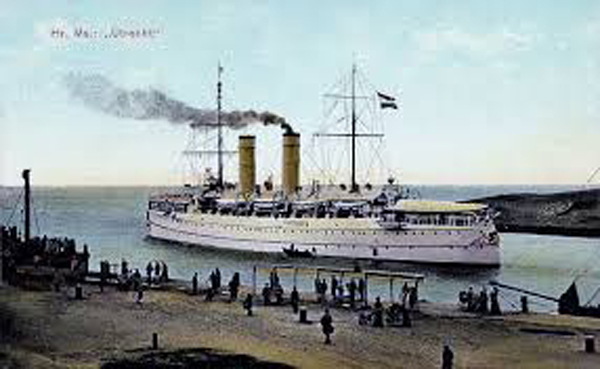
Built in two groups in various locations, launched in 1896-98 and completed by 1898-1901 these pantserdekschepen had quite an active service, seeing and participating in the Second Boer War, the Boxer war, Aceh War, or second Castro crisis. Due to budget cuts only four would remain active in 1913, two decommissioned. Holland, Zeeland saw WW1 and were discarded in 1920-24 while the last, Gelderland and Noordbrabant wee still active in 1940 as minelayers and training vessels. Both have been modernized prior to the great war.
Noordbrabant became an accommodation ship in 1920 and was badly damaged during the invasion. Captured, she was apparently not woth repairing and was discarded in May 1940 while Gelderland, a cadet training ship in the 1920s was also captured in good order. Despite her age, the Germans were desperate to use any ship they could as auxiliaries of the Kriegsmarine and she was converted as a FLAK-ship. She was efficient with a radar but was sank by air attacks in Kotka harbour in Finland on 16 July 1944.
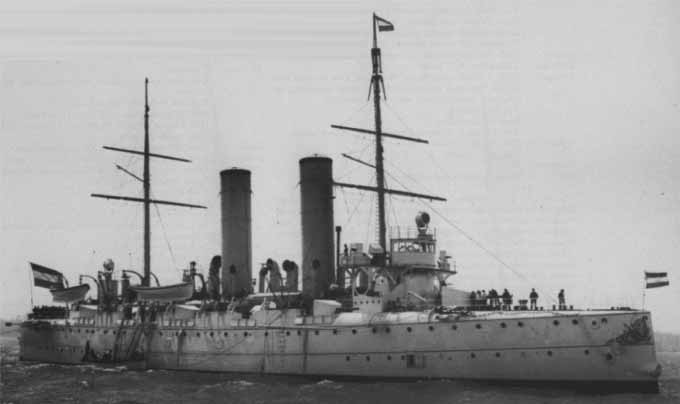
HNLMS Holland off Spithead 1902
Design of the Holland class
Built in six different yards over five years these ships were called pantserdekschepen (“armoured deck ships”) which resumed well the protected cruiser concept. They were about the same tonnage, size, and had the same armament and speed than the Apollo class. They proceeded from two rather disappointing designs. Before them indeed, the Dutch experimented with a unusual protected cruiser, the HLMNS Konigin Wilhelmina der Nederlanden, a 4530 cruiser built at Rijkswerf, Amsterdam in 1890-92 and completed in 1894. Singular, she was armed indeed with a single forward 11-in/30 gun turret (280 mm), with a single masked 8.2 in/35 gun (208 mm) aft, and two 6.7 in (170 mm) also shielded guns on the broadside.
She was though a bit as a guardship, and slow at that at 15.8 knots. Armour also was strong, up to 11 in over the boiler rooms, and 5 in elsewhere over the engine rooms. She was preceded by a smaller protected cruiser, the HLMNS Sumatra (1890), and an antiquated class of unprotected cruisers, the seven Atjeh class ships. The latter were 3,700 tons fully rigged vessels tailored for colonial service, built between 1876 and 1886. They were also the first modern steel-hull cruisers built by the Netherlands and were targeted for replacement by the new Holland class.
Due to the odd design, slow speed and short range, slow-firing armament of the Konigin Wilhelmina, the admiralty turned to foreign designs and naturally the British became a source of inspiration. The large scale Apollo class cruiser was there to see and covered all the requirements of the Dutch admiralty. Like the Apollo, they had a flush-deck hull with a central battery of 4.7 in (120 mm) guns while two fast-firing 59 in guns (149 mm) were placed fore and aft.
They also had about the same silhouette as the Apollo with two funnels and same speed at about 20 knots. Protection however was a bit sacrificed for speed in this case, only 5 in (127 mm) over the engine rooms, but the same as the Apollo.
The Holland class displaced 3,900 tons standard for the first three ships and 4,033 for the last three or 3,970 tons according to Conway’s. Their size range from 93.30 to 94.70 in lenght overall, for the same 14.80 m in width and a draught of 5.41 m.

Colorized by Postale Navales
Propulsion
The machinery consisted in two shafts reciprocating engines (VTE) which developed together 10,000 ihp (7,500 kW). This allowed for a top speed ranging from 19.5 to 20 knots or 37 km/h. Coal carried amounted to 814 up to 875 tons, while range figurs was about 4,500 nautical miles at 10 knots. The first three had eight Yarrow boilers, the last triple batch was given the same but two additional cylindrical boilers.
Armament
It consisted in two 5.9 in/37 (149 cm) Krupp guns on the deck fore and aft, under shields, six 4.7 in (12 cm) guns, three per broadside, two on boat corners fore and aft under shields and a 180° angle, and towo under walls, alternated with four 3 in (7.6 cm) guns als protected by the walls. This was completed by a light anti-torpedoboat artillery, four Hotchkiss 1pdr guns (37 mm) probably on the upper decks. This was completed by two 45 cm (18 in) torpedo tubes in the bow and stern.
However it varied considerably among ships: Zeeland for example had six 75 mm/37 Krupp guns and eight 37 mm/20 Hotchkiss, and four 37 mm/17 Hotchkiss guns.
Holland and Friesland had six 75mm/37 Krupp, and the rest as Zeeland. Gelderland, Noord Brabant and Utrecht of the second group also had eight 37mm/20 Hotchkiss and four 37mm/17 Hotchkiss QF guns.
During the modernization of 1914-15, Holland’s two 12 cm secondary guns were removed and instead two 75 mm/37, eight 37mm/20, and four 37mm/17. For NoordBrabant too, and on Zeeland and Gelderland only two 120/40 Krupp No.3 guns remained. In 1939, the surviving Gelderland was armed with eight 12.7mm/90 AA, and three 7.9 mm/80 MGs. For Gelderland in German service (Flakship Niobe) see later.
Protection
It consisted in Harvey Nickel steel. The deck was 57 mm thick (2.5 in), the glacis over the engines rooms was 127 mm (5 in), main gun shields were 152 mm thick (6 in) and the secondary gun shields were only protected by 13 mm plates, againsh shrapnells. The conning tower had walls 102 mm thick.
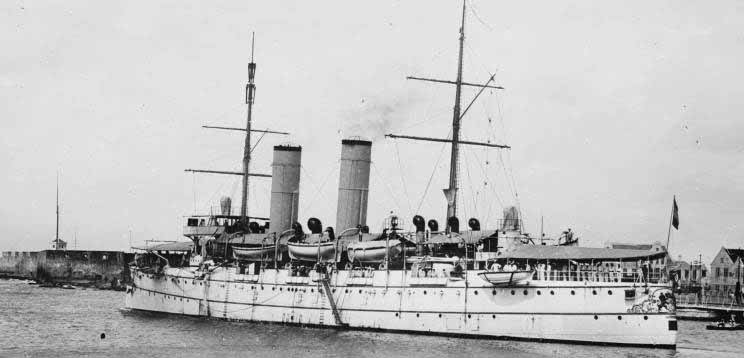
Stern view of a Holland class ship before the great war – typical white livery and beige canvas superstructures and funnels.
The Holland class in action
HNLMS Holland
Holland was launched on 4 October 1896 at Rijkswerf, Amsterdam and completed on 1 July 1898. She left Den Helder on 7 January, set for the Dutch East Indies. In 1900 she teamed with HNLMS Piet Hein and HNLMS Koningin Wilhelmina der Nederlanden to Shanghai, in order to protect Europeans at large, and Dutch citizen and company interests in Peking and China at large during the Boxer Rebellion. The Holland’s own marine infantry and landing party defended the Shanghai French Concession were most Dutch citizens took refuge.
She would returned in October to the Dutch East Indies. However ten years after, she sailed with HNLMS Hertog Hendrik, escorting HNLMS Noordbrabant damaged badly by a cliff on 31 May, sailing for Surabaya. Noordbrabant survived part of her compartments flooded and was later repaired. In 1911, Holland was sent back again to Shanghai during the turmooil caused by the Revolution and fall of Imperial China, arriving on 4 November. The next year, she represented the Dutch queen at the funeral of the Japanese emperor Meiji in Yokohama. The rest of her career was uneventful as during WWI the netherlands stayed neutral. Holland was decommissioned in 1920 and later scrapped.
HNLMS Zeeland

HNLMS Zeeland was built at the Koninklijke Maatschappij de Schelde, Flushing, launched on 20 March 1897. She was commissioned on 1 June 1898. She left the port of Flushing on 18 June that year for North Sea speed trials. She visited Plymouth in one of these. When fully operational, the new cruiser served as flagship of a naval review squadron which paraded on 15 September on the Hollands Diep, at the occasion of the coronation of queen Wilhelmina of the Netherlands.
On 24 June 1905, Zeeland tried to pull the stranded HNLMS Hertog Hendrik foundered on an uncharted reef near Matjidosteen, but this remained unsuccessful. She was mater salvaged and towed away by De Ruyter and Japara. HNLMS Zeeland sailed to to South Celebes, an expedition against the rebellion by the local lord of Boni. Hertog Hendrik, Zeeland and Assahan covered the landings near Patiro, 20 July 1905.
The next year, Zeeland, Koningin Regentes and De Ruyter sailed to Bali in the Dutch East Indies, trying to submit and integrated the southern kingdoms of Tabanan, Badung and Klungkung. The city of Denpasar was shelled on 16-17 September, covering landings which eventually put an and to any resistance. Zeeland sailed on 2 July 1914 for IJmuiden, training as far as the Baltic Sea with Prince Henry of the Netherlands on board. Copenhagen, Saint Petersburg, Stockholm and Kristiania wee visited before by the end of July she returned to Den Helder as the war was about to break out.
On 7 June 1917, Zeeland sailed to Soerabaja, visiting en route the harbors of Tórshavn, New York, Curaçao, Colon, Panama, San Francisco, Honolulu, Yokohama and Nagasaki and arriving to Soerabaja on 4 November. She became the first Dutch (or even foreign) ship through the Panama Canal. On that year she reached her destination. She sailed back home in December but her active lufe went on without notable incident. She will be decommissioned in 1924.
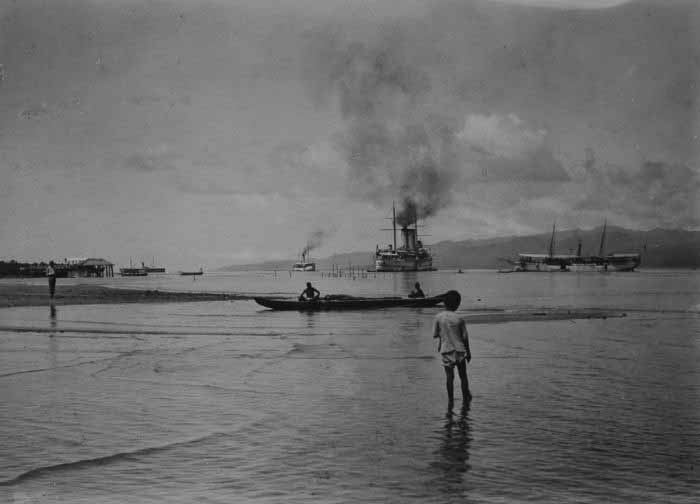
HNLMS Zeeland in the Malukku atoll in Indonesia
HNLMS Friesland

HNLMS Friesland was built at the Nederlandsche Stoomboot Maatschappij in Rotterdam, launched on 4 November 1896 and commissioned on 16 January 1898. In april the next year she sailed to Curaçao in order to protect Dutch neutrality during the Spanish-American war. She also was based in the Dutch East Indies and during the Second Boer War she ailed from Tanjung Priok in October and arrived at to Lourenço Marques. Her marine company and guns ensure the protection of Dutch citizens and interests. In August 1900 she was back in the Dutch East Indies. In 1902 she gatherred at Colombo ten Dutch volunteers from the Boer war, former POWs interned on Ceylon.
In July 1906 she left Den Helder for exercizes a far north as the Arctic Ocean, visiting Tromsø, Bergen and Kristiania. She rescued passengers from the grounded French passenger ship Ile de France and succeeded in towing her loose. Friesland collided with the British destroyer HMS Lee on 14 July 1907 off Start Point, Devon. After repairs, she, together with her sister ship Gelderland and HMDMS Jacob van Heemskerck started patrolling the Venezuelan coast during the second Castro crisis and gaurded the entry to Maracaibo in 1908. By September 1910 Friesland honored Belgian king Albert I and his wife during his state visit. She spent the rest of her two years without notable even and was decommissioned in 1913.
HNLMS Gelderland
HNLMS Gelderland was built at the Maatschappij voor Scheeps en Werktuigbouw (Fijenoord) in Rotterdam. She was launched on 28 September 1898, commissioned on 15 July 1900. By November she was in Marseille, carrying Paul Kruger from Lourenço Marques, and dropping him there, then she set sail for the Dutch East Indies. At Port Said she collided with the British steamer Peterson, and needed repairs at Suez. She resumed her trip in January 1901, arriving on 9 January in Surabaya.
By July 1904, Gelderland and Utrecht ran aground near Aroes Lampoejang, South Sumatra on uncharted reefs. They were repaired in Surabaya and Singapore. In June the next year, HNLMS Gelderland and her sisters Noordbrabant and Utrecht proceeded back home, transiting by Tanjung Priok Mahé, Perim, Port Said, Algiers and Tangier. In 1908 Gelderland patrolled the Venezuelan coast (second Castro crisis) and in 1911, she left Rotterdam for the UK, attending the coronation of George V.
On 11 November 1912 she was sent to Constantinople amidst political tensions and landed 100 marines which took position in the legations quarter on 18 November 1912. She suffered an accidental explosion occurred on 14 March 1917, and needed repairs and an overhaul. The war passed without any notable incident and she was converted as an artillery training ship.
As FLAKschiff KMS Niobe 1941-44
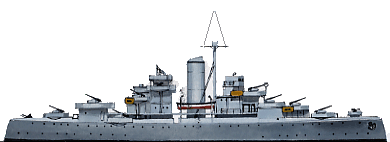
Author’s illustration of KMS Niobe
Seized by the Germans in 1940 she was integrated into the Kriegsmarine under the new name of KMS Niobe, first as cruiser, training ship, and Flakschiff or AA cruiser.
She was sent north on the baltic, to take part in the Continuation War with the Finns in order to strengthen the air defences of Kotka. Spotted by Soviet aerial reconnaissance she was attacked by 132 bombers and fighters from the 51st Mine-Torpedo Aviation Regiment of the Red Banner Baltic Fleet, on 16 July 1944. She apparently damaged several planes and shot down a A-20 Havoc bomber but she was hit multipe times and sank, her guns still blazing as she went in the shallow water. However Seventy of the crew died.

KMS Niobe in 1942
HNLMS Nordbrabant
HNLMS Nordbrabant was built in Koninklijke Maatschappij de Schelde (Flushing) launched on 17 January 1899, commissioned on 1 March 1900. Her first visit was at Kiel for the Kieler Woche where German Emperor Wilhelm II visited her. On 6 February 1901 she sailed for the Dutch East Indies, arriving in Tanjung Priok on 23 March. On 16 April she made a cruiser to Melbourne and Albany in Australia in a state visit of the Dutch East Indies towards the Australian parliament in May. In June 1905, HNLMS Noordbrabant joined Gelderland and Utrecht back in the homeland, stopping at Mahé, Perim, Port Said, Algiers and Tangier. In 1909 she made another trip from Surabaya to San Francisco, not using her sails for the first time to spare coal. She also stopped at the Marshall Islands and Hawaii. In October she participated in the Portola feasts in commemoration of the 1906 San Francisco earthquake.
In May 1910 however HNLMS Noordbrabant hit a reef en route to Surabaya, causing serious flooding but she resumed her trip on steam on her own escorted back to Surabay for repairs by Hertog Hendrik and HNLMS Holland. She was in Durrës in the summer of 1914, to retrieve the remains of Major Lodewijk Thomson back to the Netherlands. On 6 January 1916 she picked up the crew of the stranded British submarine HMS E17 on Dutch coast. After no notable incident she was decommissioned 1920 and started a new carrer as an accommodation ship. On 17 May 1940 she was scuttled by fire to avoid capture, and never repaired, scrapped postwar.
HNLMS Utrecht
HNLMS Utrecht was built at Rijkswerf (Amsterdam), launched on 14 July 1898, commissioned on 1 March 1901. In May she sailed for adelborsten to the Mediterranean Sea, visiting Cádiz, La Spezia, Naples and Toulon and was back in Flushing in July. In 1902, she sailed to Venezuela, La Guaira harbor, to deter Venezuelian actions against merchant traffic and Dutch interests. By July 1904, Utrecht and Gelderland ran aground near Aroes Lampoejang (South Sumatra) and Utrecht was repaired later in Surabaya. In September, she assisted another stranded ship, also on an uncharted reef.
On 17 June 1905, the three ships sailed back to the Netherlandsn visiting several ports, and in by September 1909, Utrecht, which was back to its Suriname station, sailed for New York City, participating in the Hudson–Fulton Celebration and a fleet review on the Hudson River while the crew, dressed in seventeenth century costumes, sailed on a replica of Hudson’s ship Halve Maen.
By 25 April 1910, she left Paramaribo in the Carribeans for Buenos Aires, in a state celebration of 100 years of Agentinian independence and the fleet review. In July, she made other stops and was backin Suriname in August. She did not even saw WW1, decommissioned in 1913.
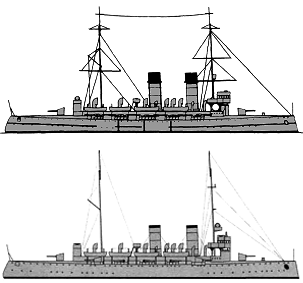
Gelderland in 1900 and 1940 (from conways and navypedia).
Read More
Conway’s all the world’s fighting ships 1906-1921 & 1922-1947
Teitler, G. (1984). De strijd om de slagkruisers. Dieren: De Bataafsche Leeuw.
van Dijk, Anthonie (1989). The Drawingboard Battleships for the Royal Netherlands Navy. Part II
//www.navypedia.org/ships/netherlands/nl_cr_holland.htm
//dawlishchronicles.com/the-strange-career-of-the-dutch-protected-cruiser-gelderland/
//www.dutchsubmarines.com/tenders/tender_ardjoeno.htm
//forum.worldofwarships.com/topic/75267-a-detailed-look-at-hnlms-gelderland/
//laststandonzombieisland.com/tag/dutch-cruiser/
//forum.worldofwarships.eu/topic/1541-hnlms-gelderland-aka-kms-niobe/
//en.wikipedia.org/wiki/Java-class_cruiser
//www.netherlandsnavy.nl/Javacl.htm
//www.navypedia.org/ships/netherlands/nl_cr_java.htm
//www.world-war.co.uk/dutch/java.php3
//marineschepen.nl/dossiers/waarom-we-de-javazee-niet-moeten-vergeten.html
//www.netherlandsnavy.nl/Javacl.htm
//www.tracesofwar.nl/articles/1924/Lichte-kruisers-van-de-Java-klasse.htm?c=gw
Kimenai, Peter (February 6, 2010)
On modelshipworld.com
Models Corner:
http://www.steelnavy.com/HollandHL.htm

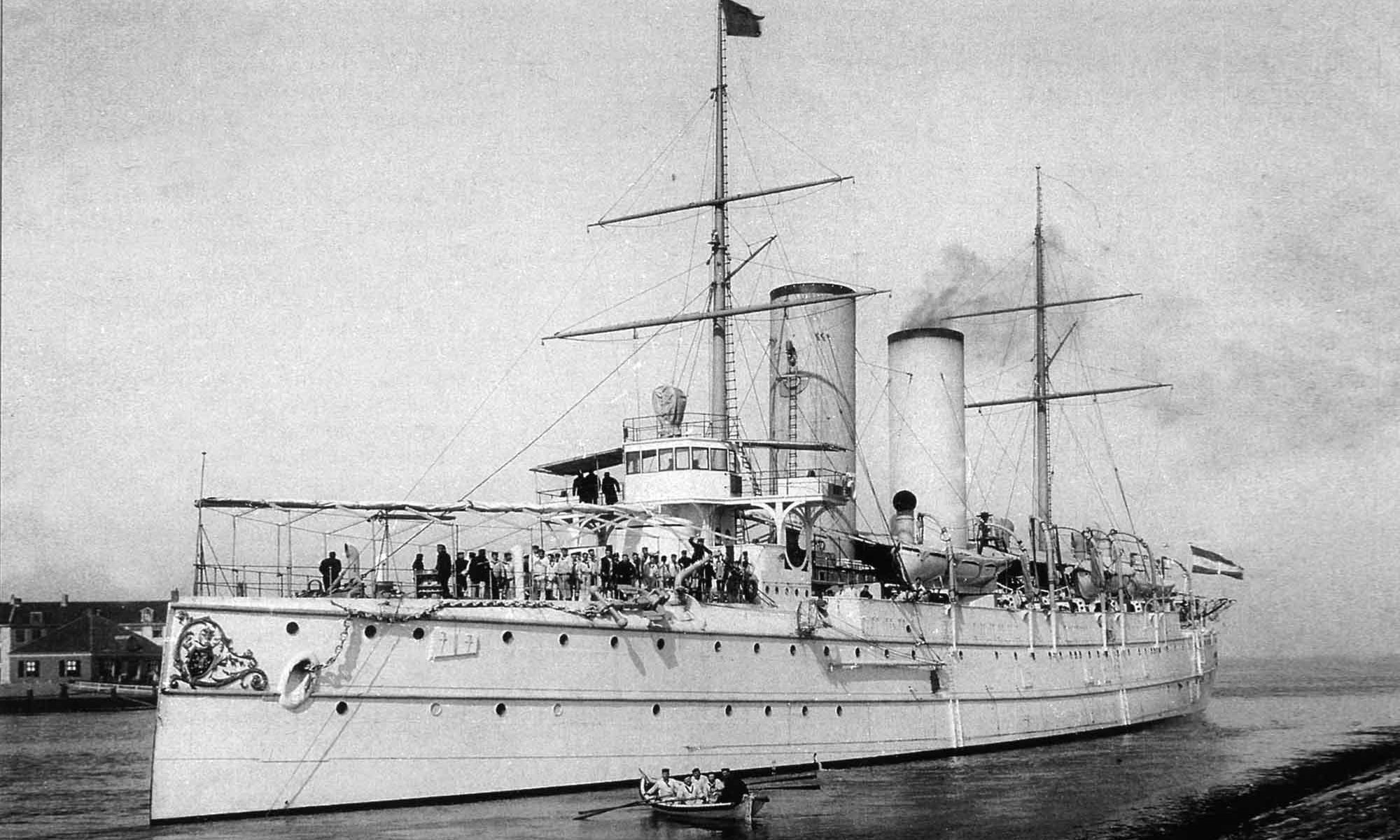

 Latest Facebook Entry -
Latest Facebook Entry -  X(Tweeter) Naval Encyclopedia's deck archive
X(Tweeter) Naval Encyclopedia's deck archive Instagram (@navalencyc)
Instagram (@navalencyc)





 French Navy
French Navy Royal Navy
Royal Navy Russian Navy
Russian Navy Armada Espanola
Armada Espanola Austrian Navy
Austrian Navy K.u.K. Kriegsmarine
K.u.K. Kriegsmarine Dansk Marine
Dansk Marine Nautiko Hellenon
Nautiko Hellenon Koninklije Marine 1870
Koninklije Marine 1870 Marinha do Brasil
Marinha do Brasil Osmanlı Donanması
Osmanlı Donanması Marina Do Peru
Marina Do Peru Marinha do Portugal
Marinha do Portugal Regia Marina 1870
Regia Marina 1870 Nihhon Kaigun 1870
Nihhon Kaigun 1870 Preußische Marine 1870
Preußische Marine 1870 Russkiy Flot 1870
Russkiy Flot 1870 Svenska marinen
Svenska marinen Søværnet
Søværnet Union Navy
Union Navy Confederate Navy
Confederate Navy Armada de Argentina
Armada de Argentina Imperial Chinese Navy
Imperial Chinese Navy Marinha do Portugal
Marinha do Portugal Mexico
Mexico Kaiserliche Marine
Kaiserliche Marine 1898 US Navy
1898 US Navy Sovietskiy Flot
Sovietskiy Flot Royal Canadian Navy
Royal Canadian Navy Royal Australian Navy
Royal Australian Navy RNZN Fleet
RNZN Fleet Chinese Navy 1937
Chinese Navy 1937 Kriegsmarine
Kriegsmarine Chilean Navy
Chilean Navy Danish Navy
Danish Navy Finnish Navy
Finnish Navy Hellenic Navy
Hellenic Navy Polish Navy
Polish Navy Romanian Navy
Romanian Navy Turkish Navy
Turkish Navy Royal Yugoslav Navy
Royal Yugoslav Navy Royal Thai Navy
Royal Thai Navy Minor Navies
Minor Navies Albania
Albania Austria
Austria Belgium
Belgium Columbia
Columbia Costa Rica
Costa Rica Cuba
Cuba Czechoslovakia
Czechoslovakia Dominican Republic
Dominican Republic Haiti
Haiti Hungary
Hungary Honduras
Honduras Estonia
Estonia Iceland
Iceland Eire
Eire Equador
Equador Iran
Iran Iraq
Iraq Latvia
Latvia Liberia
Liberia Lithuania
Lithuania Mandchukuo
Mandchukuo Morocco
Morocco Nicaragua
Nicaragua Persia
Persia San Salvador
San Salvador Sarawak
Sarawak Uruguay
Uruguay Venezuela
Venezuela Zanzibar
Zanzibar Warsaw Pact Navies
Warsaw Pact Navies Bulgaria
Bulgaria Hungary
Hungary

 Bundesmarine
Bundesmarine Dutch Navy
Dutch Navy Hellenic Navy
Hellenic Navy Marina Militare
Marina Militare Yugoslav Navy
Yugoslav Navy Chinese Navy
Chinese Navy Indian Navy
Indian Navy Indonesian Navy
Indonesian Navy JMSDF
JMSDF North Korean Navy
North Korean Navy Pakistani Navy
Pakistani Navy Philippines Navy
Philippines Navy ROKN
ROKN Rep. of Singapore Navy
Rep. of Singapore Navy Taiwanese Navy
Taiwanese Navy IDF Navy
IDF Navy Saudi Navy
Saudi Navy Royal New Zealand Navy
Royal New Zealand Navy Egyptian Navy
Egyptian Navy South African Navy
South African Navy






























 Ukrainian Navy
Ukrainian Navy dbodesign
dbodesign
collorized by PostalesNavales
https://www.facebook.com/100381150365520/photos/a.100462340357401/347795225624110/?type=3&theater
Indeed, i had the correct source but failed to credit it properly; now it’s done. Awesome work to bring these ancient archives back to life. Tried myself some colorizations but it’s much more work it seems at first glance. Since i’m a great fan of Hirootojo Jr, i see no problem to promote your work as well in other posts 😉 I heard some colorizations took almost a week full time, part of which was documentary research.
Cheers, all the best !